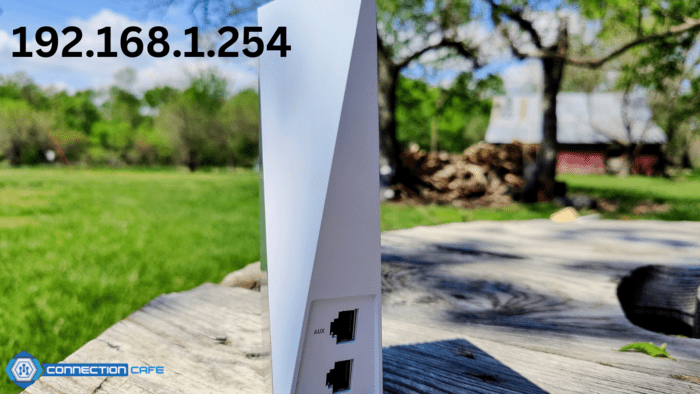The IP address 192.168.1.254 might look odd, but it is standard for many routers. You might see it when you want to update your WiFi name, password, or other settings.
Most people don’t think of something like 192.168.1.254 when they think of an internet address. Some router brands known to use this IP address are:
| Linksys | Westell | SparkLAN |
| 2Wire | Motorola | 3Com |
| Aztech | CenturyLink | Thomson |
| Alcatel | Netopia Cayman | Billion |
The IP address 192.168.1.254 might seem unusual to those not familiar with computer networks, but it’s not odd at all.
It is just one of the IP addresses set aside for private networks by two groups: the Internet Engineering Task Force (IETF), which creates and encourages Internet standards, and the Internet Assigned Numbers Authority (IANA), a nonprofit organization in America that manages the distribution of IP addresses worldwide.
Everything You Need to Know About Private IP Addresses
Every device on a computer network that uses Internet Protocol has an IP address. This is a numeric label that identifies hosts and helps locate them.
IP addresses help identify and locate hosts and network interfaces.
IP addresses are difficult to remember, so we often use domain names to connect to computers, services, or other resources online.
Many people don’t know that when you type a domain name in your web browser’s URL bar, it gets converted to an IP address. This happens through a system called the Domain Name System (DNS).
Not every IP address is for public use. In the IPv4 address space, which most devices use, there are three ranges reserved for private networks.
- 10.0.0.0 to 10.255.255.255: This range has 16,777,216 private IP addresses in a 24-bit block.
- 172.16.0.0 to 172.31.255.255: This range includes 1,048,576 private IP addresses in a 20-bit block.
- 192.168.0.0 to 192.168.255.255: This range holds 65,536 private IP addresses in a 16-bit block.
The 192.168.1.254 IP address falls within the 16-bit block, which includes 65,535 other private IP addresses. A router using the 192.168.1.254 IP address typically gives devices connected to it other private IPs from the same group, like 192.168.0.1, 192.168.1.1, 192.168.2.1, etc.
How to Log In to 192.168.1.254?
When you type 192.168.1.254 into your browser’s URL bar, you will likely see a login screen.
Make sure to enter the IP address exactly as shown. Typing www.192.168.1.254, 192.168.1.254.com, or www.192.168.1.254.com will not work. These will lead to an “ERR_NAME_NOT_RESOLVED” error in your browser.
The 192.168.1.254 login screen leads to your router’s admin panel.
To get in, you need your router login password. Often, this password is on a sticker on your router’s bottom or back. You might also find it in the router’s manual.
What if I Forgot My Router Password?
If you’ve lost your router password and haven’t changed it before, try using typical login and password combinations for routers:
| Login | Password |
| admin | admin |
| admin | password |
| user | user |
| user | password |
| admin | Michelangelo |
| admin | 12345 |
| admin | 123456 |
| admin | 1234567 |
| admin | 12345678 |
| admin | 123456789 |
If the suggested combinations of admin usernames and router passwords don’t let you into your router settings, try searching “how to log into router + your router’s name” on Google or look up the list of default router login details.
How Can I Access My Router’s Admin Panel?
Unfortunately, there isn’t a one-size-fits-all method to access every router’s admin panel. Each router varies a bit, so you might need to try different things to get in.
Step 1: Open your preferred web browser.
Step 2: Type http://192.168.1.254 in the address bar and press enter. Address bar 192.168.1.254
If you are reading this, you might already know that your router’s IP address is 192.168.1.254. If not, you can check by typing “ipconfig” in the terminal and looking for “Default Gateway” under “Local Area Connection.”
Step 3: Enter your admin username and password.
If you run into problems accessing your router’s admin panel, consider resetting your router to its original settings.
Most routers have a small, hidden button on the back or bottom. You can press it with something sharp, like a pen. Keep pressing until the lights start flashing. Wait a couple of minutes for your router to restart, then try accessing the admin panel again.
How Can I Check My Connection?
After you change your router’s passwords and adjust its settings, you need to see if you can still go online and if your download and upload speeds are fast. Use tools like wireless site surveys, Wi-Fi analysis, and troubleshooting apps like NetSpot.
NetSpot is simple and affordable. It shows you maps of your Wi-Fi coverage, tells you about your security settings, and finds nearby Wi-Fi networks to help you choose the best wireless channel.


